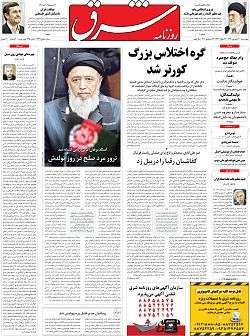Shargh
 | |
|
The front page of Shargh on 21 September 2011, announcing assassination of Burhanuddin Rabbani, former president of Afghanistan | |
| Type | Daily newspaper |
|---|---|
| Format | Broadsheet |
| Owner(s) | Mehdi Rahmanian |
| Publisher | Golriz Institute |
| Editor | Ahmad Gholami |
| Founded | 2003 |
| Headquarters | Argentina Street, Tehran, Iran |
| Circulation | 30,000 Daily (2015)[1] |
| Website |
www |
Shargh ("شرق" lit. "East") is the most popular reformist newspaper in Iran.[2]
History and profile
Shargh was founded in 2003.[3][4] The daily is managed by Mehdi Rahmanian. Its chief editor was Mohammad Ghouchani in its first period of publication. Mohammad Ghouchani and Mohammad Atrianfar, its ex-head of policy-making council, left Shargh in March 2007 and joined Ham-Mihan, another reformist newspaper managed by Gholamhossein Karbaschi.
Some people claim that the newspaper has a hidden agenda of helping the political goals of the Executives of Construction Party (Hezb-e Kaargozaaraan-e Saazandegi), including trying to nominate Akbar Hashemi Rafsanjani for the 2005 Iranian presidential election and then making him win the popular vote.
Arash Karami, an Iranian journalist, described Sharg as the opposite of conservative paper Kayhan in terms of political stance.[5]
Bans
Shargh had published 141 editions before the temporary ban by the Iranian judiciary system on 4 February 2004, one day before the parliament election, following the publication of an open letter from some members of the outgoing parliament to Ayatollah Khamenei, the Supreme Leader. The letter was read to journalists by Mohsen Armin, one of the organizers of the MPs sit-in criticizing the vettings of the Council of Guardians.
The situation got more interesting when Mehdi Rahmanian, Shargh's manager in charge, met Saeed Mortazavi, Tehran's general prosecutor, the next day to discuss a removal of the ban. After that, Rahmanian wrote a public letter asking for forgiveness, saying that he couldn't confirm that the letter was actually from the MPs and signed by them, and that even in the case it was, it would have been a non-professional act to publish "offensive" texts.
Mortazavi announced that he had ordered the ban because of a request by the High Council of National Security, which Hassan Rowhani, the council's chair, and Mohammad Khatami, the president, later denied on 20 and 23 February, respectively, mentioning the matter was not even discussed at the council's meeting. The ban was removed on 28 February 2004, and Shargh was published again from 3 March 2004.[6] Shargh was shut down again on 11 September 2006 by the Iranian government.[7]
In March 2007, Iran's hardline judiciary allowed a number of banned reformist dailies to republish, including the flagship centrist daily Shargh after a half-year ban.[6] However, the daily was banned after publishing an interview with Iranian-Canadian poet Saghi Ghahraman in August 2007.[4] The interview was viewed as counter-revolutionary and immoral by the press directory.[3]
The digital newspaper Your Middle East reported on 26 September 2012 that Shargh had been banned over a controversial cartoon.[2][8] The newspaper, one of the few remaining dailies close to the reformists, published the cartoon on 25 September and provoked anger among Iranian lawmakers as well as officials, who said the cartoon insulted Iranian fighters in the Iran–Iraq War (1980–88).[2] Iranian soldiers usually had ribbons reading holy words on their foreheads during the war.[2]
See also
References
- ↑ تیراژ واقعی روزنامهها چقدر است؟
- 1 2 3 4 "Controversial cartoon led to ban on reformist Iranian newspaper". Your Middle East. 2 October 2012. Retrieved 19 September 2013.
- 1 2 "Iran shuts down leading reformist newspaper". Canada.com. 6 August 2007. Retrieved 6 October 2013.
- 1 2 Ali Akbar Dareini (6 August 2007). "Iran Shuts Leading Reformist Paper". The Washington Post. AP. Retrieved 15 October 2013.
- ↑ Arash Karami (15 March 2014). "Iran's Fourth Estate". Asharq Al Awsat. Retrieved 22 September 2014.
- 1 2 Controversial cartoon led to ban on reformist Iranian newspaper Time, Azadeh Moaveni 11 September 2006
- ↑ Martin Albrow; Helmut K Anheier; Marlies Glasius; Mary Kaldor, Monroe E Price (2008). Global Civil Society 2007/8: Communicative Power and Democracy. SAGE Publications. p. 106. ISBN 978-1-4129-4800-5. Retrieved 3 October 2015. Cite uses deprecated parameter
|coauthors=(help) - ↑ Arash Karami (13 March 2014). "Iran's Fourth Estate". The Majalla. Retrieved 6 September 2014.
